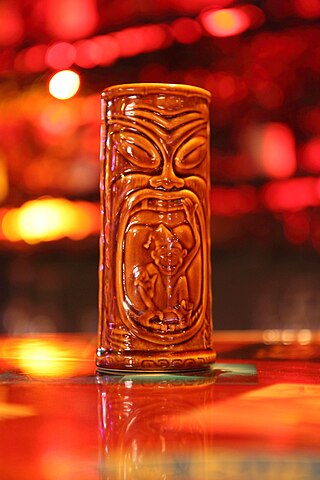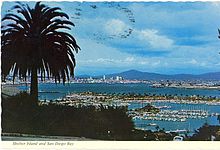
A harbor, or harbour, is a sheltered body of water where ships, boats, and barges load and unload. The term harbor is often used interchangeably with port, which is a man-made facility built for loading and unloading vessels and dropping off and picking up passengers. Harbors usually include one or more ports. Alexandria Port in Egypt, meanwhile, is an example of a port with two harbors.

Tiki culture is an American-originated art, music, and entertainment movement inspired by Polynesian, Melanesian, and Micronesian cultures, and by Oceanian art. Influential cultures to Tiki culture include Australasia, Melanesia, Micronesia, Polynesia, the Caribbean Islands, and Hawaii. The name comes from Tiki, the Māori name for the first human, often represented in the form of hei-tiki, a pendant and important taonga. The hei-tiki was often appropriated by Europeans as a commercialised good luck charm, hence the name of Tiki culture. Despite spanning over 10,000 miles and including many different unrelated cultures, religions, and languages, Tiki aesthetic is considered by some to be amalgamated into one "fantasia of trans-Pacific cultures" and "colonial nostalgia". Because of this, and the simplistic view of the Pacific taken by the aesthetic, Tiki culture has often proved controversial.

Newport Beach is a coastal city of about 85,000 in southern Orange County, California, United States. Located about 40 miles (64 km) southeast of downtown Los Angeles, Newport Beach is known for its sandy beaches. The city's harbor once supported maritime industries. Today it is used mostly for recreation. Balboa Island draws visitors with a waterfront path and easy access from the ferry to the shops and restaurants.

Apra Harbor, also called Port Apra, is a deep-water port on the western side of the United States territory of Guam. It is considered one of the best natural ports in the Pacific Ocean. The harbor is bounded by Cabras Island and the Glass Breakwater to the north and the Orote Peninsula in the south. Naval Base Guam and the Port of Guam are the two major users of the harbor. It is also a popular recreation area for boaters, surfers, scuba divers, and other recreationalists.

San Diego Bay is a natural harbor and deepwater port in San Diego County, California, near the Mexico–United States border. The bay, which is 12 miles (19 km) long and 1 to 3 miles wide, is the third largest of the three large, protected natural bays on California's 840 miles (1,350 km) of coastline, after San Francisco Bay and Humboldt Bay. The highly urbanized land adjacent to the bay includes the city of San Diego and four other cities: National City, Chula Vista, Imperial Beach and Coronado. The bay is considered to be one of the premier natural harbors on the West Coast.
The Embarcadero in San Diego, California, is the area along the San Diego harbor on the east side of San Diego Bay. "Embarcadero" is a Spanish word meaning "boarding place". The Embarcadero sits on property administered by the Port of San Diego, in the Columbia district of downtown San Diego.

Disney's Polynesian Village Resort is a Disney-owned and operated resort located at the Walt Disney World Resort. It began operation on October 1, 1971 as one of Walt Disney World Resort's first two on-site hotels. The resort has a South Seas theme, and originally opened with 492 rooms. It was designed by Welton Becket and Associates and constructed by US Steel Realty Development. The resort is owned and operated by Disney Parks, Experiences and Products.

San Diego Yacht Club (SDYC) is a private yacht club in San Diego, California. Founded in 1886, it is one of the oldest in the United States. The club won the America's Cup in 1987, 1988, and 1992.

A tiki bar is a themed drinking establishment that serves elaborate cocktails, especially rum-based mixed drinks such as the Mai Tai and Zombie cocktails. Tiki bars are aesthetically defined by their tiki culture décor which is based upon a romanticized conception of tropical cultures, most commonly Polynesian. Some bars also incorporate general nautical themes or retro elements from the early atomic age.

Hebe Haven, also known as Pak Sha Wan, is a harbour on the south shore of Sai Kung Peninsula in Hong Kong.

Point Loma is a seaside community in San Diego, California, United States. Geographically it is a hilly peninsula that is bordered on the west and south by the Pacific Ocean, the east by San Diego Bay and Old Town, and the north by the San Diego River. Together with the Silver Strand/Coronado peninsula, the Point Loma peninsula defines San Diego Bay and separates it from the Pacific Ocean. The term "Point Loma" is used to describe both the neighborhood and the peninsula.

The Port of Redwood City is a marine freight terminal on the western side of the southern San Francisco Bay, on the West Coast of the United States. This marine terminal is situated within the city of Redwood City, California. The port was developed from a natural deepwater channel discovered in the year 1850, at the mouth of Redwood Creek. From the early use as a log float port, commercial use expanded to a variety of industrial commodities; moreover, it is considered the birthplace of shipbuilding on the North American west coast. As of 2004 the annual freight shipments have reached about two million metric tons. The Port of Redwood City provides berths for dry bulk, liquid bulk, and project cargoes, along with certain recreational opportunities and public access to San Francisco Bay.

The Port of San Diego is a seaport in San Diego, California. It is located on San Diego Bay in southwestern San Diego County, and is a self-supporting district established in 1962 by an act of the California State Legislature. In addition to port activities, the Port District controls San Diego Bay and owns and manages the bay's immediate waterfront under the state's Tidelands Trust.

Harbor Island is a man-made peninsula created in 1961 from harbor dredgings, located in San Diego Bay in San Diego, California. It lies between Shelter Island and downtown San Diego, and is directly across Harbor Drive from San Diego International Airport. It is 2 miles (3.2 km) long and only a few hundred feet wide. A single road, Harbor Island Drive, runs from one end of Harbor Island to the other and connects it to the mainland.
La Playa is a bayfront neighborhood in the Point Loma community of San Diego, California. It is bordered by San Diego Bay to the east, Naval Base Point Loma to the south, the Wooded Area neighborhood to the west, and Point Loma Village/Roseville-Fleetridge to the north. It lies across a channel from Shelter Island.

Echo Bay is an embayment located off Long Island Sound in the city of New Rochelle in Westchester County, New York. It is an anchorage for small craft and is generally fully occupied during the summer. The depths at the anchorage range from 4 to 15 feet, and launches can anchor in the shallow cove on the northeast side of the harbor, entering between Harrison Islands and the rocky, grassy islet off the northwest side of Echo Island. Vessels frequently anchor between the entrance of Echo Bay and Hicks Ledge, in depths of 20 to 24 feet. On the northwest side of Echo Bay a dredged channel 100 feet wide and 15 feet deep, marked by buoys, leads to the New Rochelle Municipal Marina at Beaufort Point.

Fireboats in San Diego have been operated on San Diego Bay in the San Diego, California, area since the early 20th century, as well as by the Port of San Diego since its creation as a quasi-governmental agency serving the entire bay in 1962.
















